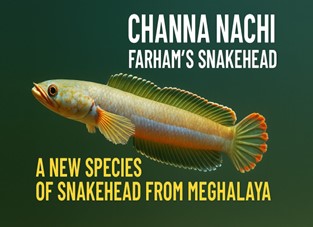Channa nachi: New Snakehead Fish Discovered in Meghalaya
Why in News ?
Channa nachi, a newly discovered snakehead fish species from Meghalaya, India, features a unique bicolor pattern and distinctive markings. Its discovery highlights the ecological importance of conserving freshwater habitats and enriching India’s aquatic biodiversity.
Habitat and Discovery:
- Channa nachi, a newly identified species of snakehead fish, has been discovered in Meghalaya, India.
- It was found in a shallow, slow-moving stream flowing into the Simsang River near Chokpot village.
- The habitat consists of sandy substrates, leaf litter, and pebble-strewn floors, ideal for unique freshwater species.
- This region also hosts species like Schistura reticulofasciata, Dario kajal, and Barilius bendelisis.
Distinctive Features of Channa nachi
- The species has a slender, elongated body with a distinctive bicolor pattern—creamish-yellow transitioning into greyish-blue.
- Its ventral side has pale-blue marbling, while the dorsal half displays 10–12 pale brown saddles.
- Unlike many snakeheads, it lacks spots or blotches and has no transverse markings on its caudal fin.
- These unique traits set it apart from other snakehead species.
Significance of the Discovery
- The identification of Channa nachi enhances India’s ichthyological diversity and underscores the ecological importance of freshwater habitats.
- This discovery emphasizes the need for conservation efforts to protect lesser-known aquatic species and preserve biodiversity.
- The rich ecosystem of Meghalaya’s freshwater bodies continues to reveal hidden aquatic treasures, showcasing the region’s environmental significance.




